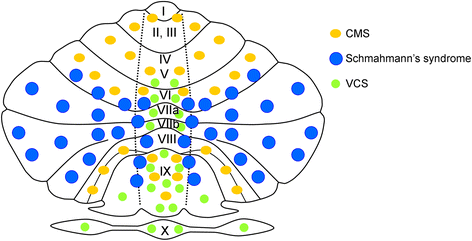Schmahmann's syndrome - identification of the third cornerstone of clinical ataxiology
- PMID: 26331045
- PMCID: PMC4552302
- DOI: 10.1186/s40673-015-0023-1
Schmahmann's syndrome - identification of the third cornerstone of clinical ataxiology
Abstract
Schmahmann's syndrome represents a novel clinical condition consisting of a constellation of cognitive and affective deficits following cerebellar disease. The complex was first described in 1998 as cerebellar cognitive affective syndrome (CCAS) on the basis of a careful neurological examination, detailed bedside mental state tests, neuropsychological investigations and anatomical neuroimaging of a group of 20 patients with focal cerebellar disorders. The syndrome was characterized by four clusters of symptoms including: (a) impairment of executive functions such as planning, set-shifting, verbal fluency, abstract reasoning and working memory, (b) impaired visuo-spatial cognition, (c) personality changes with blunting of affect or abnormal behaviour, and (d) language deficits including agrammatism, wordfinding disturbances, disruption of language dynamics and dysprosodia. This complex of neurocognitive and behavioural-affective symptoms was ascribed to a functional disruption of the reciprocal pathways that connect the cerebellum with the limbic circuitry and the prefrontal, temporal and parietal association cortices. With the introduction of Schmahmann's syndrome, clinical ataxiology has found its third cornerstone, the two others being the cerebellar motor syndrome (CMS) mainly delineated by the pioneer French and English neurologists of the 19(th) and early 20(th) century, and the vestibulo-cerebellar syndrome (VCS) consisting of ocular instability, deficits of oculomotor movements and ocular misalignment.
Keywords: Affect; Cerebellar cognitive affective syndrome; Cognition; Emotion; Executive functions; Language; Posterior fossa syndrome; Spatial cognition.
Figures


References
-
- Trouillas P, Takayanagi T, Hallett M, Currier RD, Subramony SH, Wessel K, et al. International Cooperative Ataxia Rating Scale for pharmacological assessment of the cerebellar syndrome. The Ataxia Neuropharmacology Committee of the World Federation of Neurology. J Neurol Sci. 1997;145:205–211. doi: 10.1016/S0022-510X(96)00231-6. - DOI - PubMed
-
- Larsell O. Lobules of the mammalian and human cerebellum. Anat Rec. 1958;130:329–330.
LinkOut - more resources
Full Text Sources
Other Literature Sources

